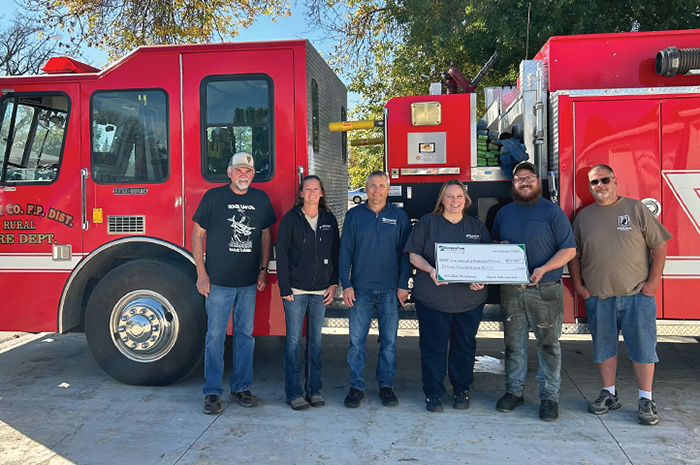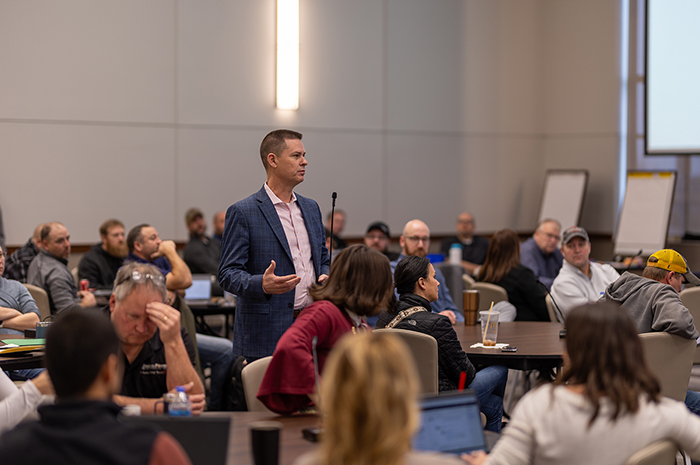Cooperative learning on the fly
This winter, Minnkota and Great River Energy collaborated to test new drone inspection technology.
“Taking off!”
As soon as the words left Jay Driver’s mouth, a sharp whir cut over the gravel road deep in rural Polk County, Minnesota. The DJI Matrice 350 drone found its lift as representatives from Minnkota Power Cooperative and Great River Energy (GRE) watched, following the airborne technology as it drifted above the 69-kilovolt (kV) power poles to their right.
Minnkota had been experiencing blink outages on this remote span of line for months, with no evident cause. With the new partial discharge sensor attached to GRE’s drone, Minnkota engineers Brenden LaHaise and Evan Edwards were hoping to reveal some answers.
“When we get a number of faults in a repeated area in a short timeframe, we know there's a problem there,” Edwards said. “We have lightning data, so we can see where lightning strikes are occurring in the system. And we can't correlate any lightning strikes to these line sections when these faults are happening.”

The engineers learned that Minnkota’s generation and transmission cooperative counterpart in Minnesota, GRE, had recently purchased a partial discharge sensor for its drone fleet. With this diagnostic attachment, a drone pilot can see the light waves of electrical discharge around an insulator, which can’t be seen with the eye. This discharge – shown on the display as a series of red dots – could indicate cracked or loose equipment.
As GRE’s Jay Driver continued to fly the drone south, pausing above each pole for an inspection, GRE’s UAS Program Manager Andy Regnier acted as an extra set of eyes on the horizon. Regnier is responsible for overseeing a dozen drones of this kind used in co-op line and substation inspections, thermal surveys, LiDAR (Light Detection and Ranging) flights and more.
“We've done quite a bit with it internally,” he said of the partial discharge sensor. “We’ve looked at a couple troubled lines and found issues. This year, we're expanding it to make it a routine inspection for some older aging lines, and particularly line taps. We're going to try to tackle several miles a year.”

Although Minnkota has its own Matrice 350 drone, it hasn’t yet purchased a partial discharge sensor – GRE is one of the early utility adopters of that type of payload. This collaborative flight was a way to not only hunt for an invisible transmission line issue but also to test drive a new technology.
“In situations like this,” Regnier said, “we can help co-ops out and we learn along the way, too.”
The drone zone
Minnkota engineer Brenden LaHaise has been leading his team’s foray into drone technology since his first purchase of a DJI Mavic 2 Pro in 2019. The small drone is equipped with a camera and has been used for visual inspections for vegetation management, transmission faults and substation mapping. However, the drone is unable to carry additional sensors for more refined surveys.
“We eventually were able to make the business case that we've used a small one and we've seen benefits from using it,” LaHaise explained. “But thermal imaging would be nice on one, and of course a better zoom camera.”

In 2024, Minnkota advanced its drone program by purchasing a DJI Matrice 350 with the capability to mount third-party sensors. As the program matures, LaHaise will be able to research and purchase additional attachments to bring certain contracted surveys and inspections in-house, which could save the cooperative time and money in the long term. He hopes to eventually apply for an FAA waiver to allow drone flights beyond visual line of sight, allowing even more efficiency.
“That's where I see this program going. We can have smaller drones that all have a similar capability, and we can have larger drones for longer and more specialized inspections,” LaHaise said.
“We’re asking, ‘Can we inspect it quicker? Can we find the smoking gun, the areas that are causing the biggest issue?’ If so, we can go and do spot fixes instead of having to go and reinsulate the whole section,” Edwards said. He added that, in some instances, pinpointing small equipment replacements could end up extending the life of an aging line by 10 or more years.
In the case of Minnkota’s collaborative flight with GRE, two drones with differing sensors (partial discharge on GRE’s and thermal on Minnkota’s) flew a 3.5-mile stretch of nearly 50 poles. In just three to four hours, the two drone pilots collected two layers of data on the infrastructure. No electrical discharge or hot spots were noted, but even this “lack of a problem” can help Minnkota rule out another cause of the blink outages.

Beyond savings and efficiency, Minnkota and GRE agree that the biggest benefit of drones in the utility space is additional safety.
“My goal all along is to keep people out of a bucket. Someone would have to physically go in a bucket of a bucket truck, go up 90 feet to the pole, and then take a look at what we're looking at with the drone,” GRE’s Regnier said. “It's rewarding when you can use this technology and keep someone out of a bucket.”
Although GRE may have a different inventory of drone technology than Minnkota, the two co-ops share the exact same cooperative principles – including “Cooperation Among Cooperatives.” No matter how big or how small, rural electric cooperatives are forever willing to extend a hand. Or a propeller.
“We're all trying to utilize the same technology and solve the same problems,” Edwards said. “So being able to share what we're learning, share what we're experiencing and work together to solve the same problems, using the same technology, is really nice and really helpful.”
MAIN IMAGE: Minnkota and GRE representatives stand by as GRE's Jay Driver (foreground) sets up his drone for flight. (Minnkota/Michael Hoeft)
...



